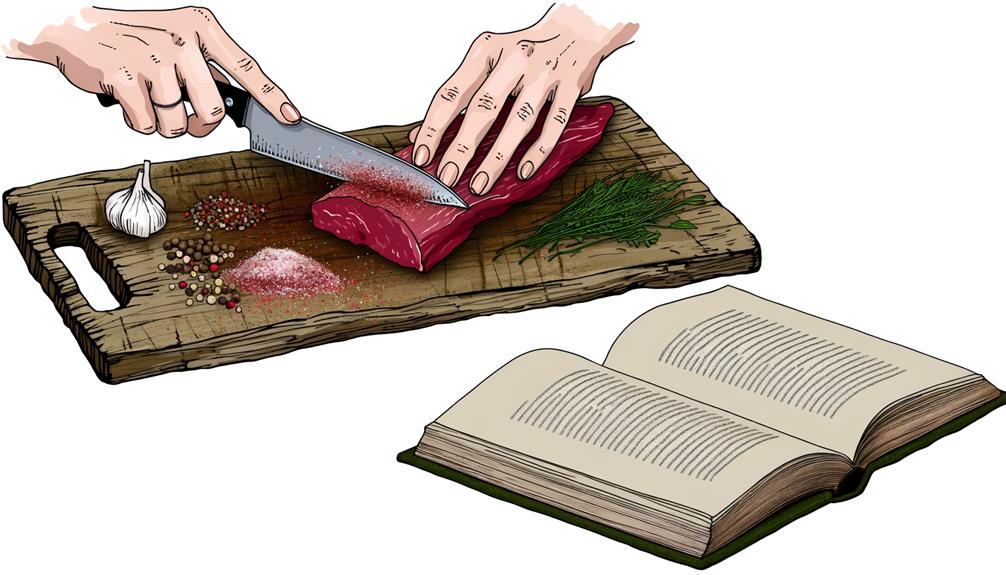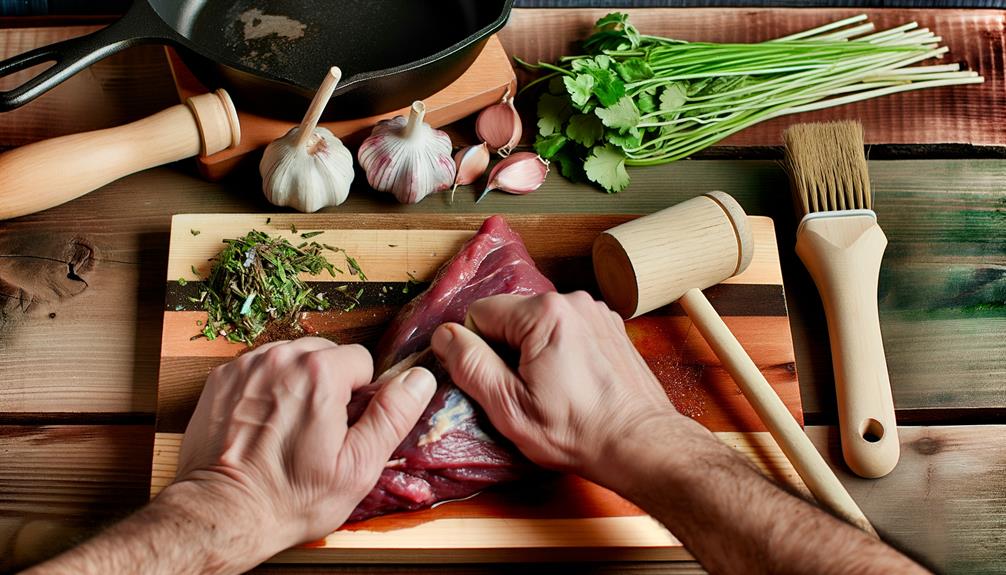To cook a venison backstrap, first, I remove the silverskin. I then season the meat simply with salt, pepper, and perhaps some herbs. I cook it quickly and on high heat to preserve its tenderness, aiming for medium-rare doneness. Once done, it's essential to let the backstrap rest before serving to keep the juices intact. The result? A meal that celebrates this prime cut's natural flavor. But there's a wealth of variety in how this delicacy can be prepared – trust me, there's more to explore with this culinary treat.
Venison Backstrap's Culinary Origins
Let's explore the culinary origins of venison backstrap, a cut of meat highly valued by wild game enthusiasts for its tender and lean profile. This prime cut, likened to beef ribeye, comes from the loin of the deer. It's a sought-after component in wild game cooking, admired for its remarkable tenderness and slim fat content.
The preparation of the backstrap varies, with cooking methods ranging from roasting to grilling or searing. Each method aims to accentuate the meat's delicate flavor. I've found that to retain the backstrap's tenderness and juiciness, it's essential to season it properly with salt and cook it to a medium-rare doneness at a temperature between 115-125°F.
My favorite way to cook venison backstrap is using a cast iron skillet. The heat conduction allows for an even cook, which is crucial in preserving its tenderness. The recipe I use is simple, letting the meat shine in its natural flavor.
When cooked correctly, venison backstrap isn't just a delicious wild game dish, but an impressive centerpiece for special occasions or family meals. Understanding its origins and the key to cooking it properly can transform this prized cut into a truly delectable meal.
Essential Recipe Components
When preparing venison backstrap, it's important to get a few key elements right: the seasoning, the cooking method, and the resting time.
Let's start with the seasoning. For this game, it's important to keep it simple, so the natural flavor of the venison backstrap shines. Salt and pepper will do just fine.
Next, we have the cooking method. Venison backstrap is a tender cut of meat that needs to be cooked hot and fast. Grilling or searing is perfect for this. Remember, it's best to aim for medium rare, as this will keep the meat tender and flavorful.
Finally, the resting time. After you cook the backstrap, let it rest for a few minutes before slicing. This allows the juices to redistribute, ensuring a moist and flavorful bite.
Here's a table summarizing these essential components:
| Component | Description | Key Point |
|---|---|---|
| Seasoning | Simple, to enhance natural flavor | Salt and pepper |
| Cooking Method | Hot and fast, to preserve tenderness | Grilling/Searing |
| Resting Time | Allows juices to redistribute | Wait a few minutes |
Keep these components in mind, and you'll make a delicious venison backstrap.
Backstrap Preparation Guide

Before diving into the cooking process, it's crucial to prep your venison backstrap properly to ensure the best flavor and tenderness. Your backstrap preparation starts with removing any silverskin. This thin, tough membrane can make the lean cut chewy, so it's ideal to trim it off.
Next, it's time for seasoning. A simple rub of salt and pepper can suffice, but a blend of garlic and rosemary can add complexity. You could also consider a marinade; a mix of olive oil, garlic, and balsamic vinegar works well with venison.
When it comes to cooking venison backstrap, consider these three points:
- Roasting venison is less labor-intensive than other methods. Set your oven to high heat and sear the meat quickly to lock in juices.
- Aim for medium-rare doneness. Overcooking can make the tender cuts dry out as venison is a lean meat.
- Don't forget the resting time. Allowing the cooked backstrap to rest for 10 minutes before slicing helps retain its juices.
Follow these steps, and you'll be well on your way to a succulent venison backstrap recipe.
Expert Tips
Now, let's move on to some expert tips for cooking venison backstrap that will elevate your dish to the next level.
We'll discuss how to select a quality backstrap, the proper cooking techniques to use, and how to season and serve your venison.
It's all about mastering these key points to achieve a tender, juicy, and flavorful venison backstrap.
Selecting Quality Backstrap
Selecting a top-notch backstrap is essential for the best flavor and it should have a deep red color with minimal to no visible fat. When I'm picking out a venison backstrap, I look for these key indicators of quality.
The cut should be well-trimmed, with little to no silver skin remaining. It's also important to check for a clean, gamey smell. Any off-putting odors could signal a lack of freshness. The meat should be free of discoloration or excessive bruising. I also make sure it's firm to the touch.
A slightly glossy appearance can indicate the backstrap is fresh and ready for cooking. Selecting the best cut is the first step in the journey to a delicious venison dish.
Proper Cooking Techniques
To guarantee your venison backstrap is tender and juicy, it's crucial to utilize hot and fast cooking methods and refrain from overcooking. The key is to sear the backstrap quickly on a high heat, sealing in the flavor and moisture. This approach ensures the meat remains tender.
Keep in mind, you're aiming for a medium-rare doneness, around 115-125°F. Any more, and you risk drying out your venison. Once cooked, let it rest for a while. This allows the juices to redistribute, keeping the backstrap moist.
These expert tips are fundamental cooking techniques to master. They'll ensure your backstrap is always tender, moist, and full of flavor. Overcooking is a common mistake, but with these tips in mind, you'll avoid it every time.
Seasoning and Serving
With just the right blend of salt, black pepper, garlic powder, and rosemary, you'll dramatically enhance the flavor of your venison backstrap. To make this recipe, rub the backstrap and tenderloin generously with the seasonings, then drizzle some olive oil in a hot pan.
Brown the venison tenderloin on all sides for a few minutes until the internal temperature reaches your desired level. Now, here's an important tip: let the meat rest for 10 minutes before cutting. This allows the juices to redistribute, intensifying the flavor of the meat.
Serving is where you can get creative. A classic pairing with mashed potatoes and green beans never disappoints. Enjoy your perfectly seasoned and cooked venison backstrap!
Final Thoughts
To wrap up, mastering the art of cooking venison backstrap can truly elevate your culinary skills, allowing you to present a lean, tender, and flavorful dish that's sure to impress. Cooking venison, especially a venison loin or deer backstrap, is an art that demands attention to detail. The best way to cook this meat is to roast venison at high heat to seal in its natural juiciness.
The tenderloin and backstrap are similar cuts, both known for their tenderness and rich flavor. Both should be cooked to medium-rare for the best results. Overcooking will lead to a loss of juiciness and tenderness, so it's essential to monitor the temperature closely.
Seasoning plays a significant role in enhancing the flavor of the venison. I recommend using herbs, garlic, and spices to create a taste profile that complements the meat's natural flavors.
